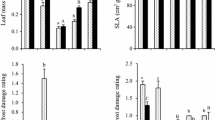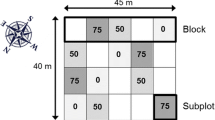Summary
Results of experiments with four poplar clones and various chemical fertilizers in a nursery in southern Greece are presented. At the end of the first growth period the heights of the four clones, without fertilizers, decreased in the order of I-214>I-262>cv. campeator > black poplar 1/64 with significant differences only between black poplar 1/64 and the rest of the clones.
Of the fertilizer nutrients N, P, K and Mg only N improved heights of all clones significantly and especially of the clone I-214. One hundred and 200 kg of P fertilizer per ha had minimal or negative effect on height increase of all clones.
Ammonium sulfate, ammonium nitrate and potassium nitrate all at 400 kg N per ha were found equally effective in improving height growth of the clone I-214 but ammonium nitrate is the N fertilizer of choice by its higher N content and relatively lower price.
Ammonium nitrate at 200 kg N per ha, in two or three equal dosages, during the first growth period, June–July, gave the maximum height increase for two consecutive years of the clone I-214. Six hundred kgs, of N per ha reduced height increase of the same clone and increased losses of N, as NO3 −, in drainage water.
Similar content being viewed by others
References
Alexandris, S. G. 1972 The effect of different fertilizer treatments on the nutrient status and growth of one year old poplar trees from cuttings. For. Res. Stn of Northern Greece. Publ. no.56, 44 pp. (English summary).
Baker, J. B. and Broadfoot, W. M. 1976 Soil requirements and site selection forAigeiros poplar plantations. Proceedings: Symposium on eastern cottonwood and related species. pp. 328–343.
Blackmon, B. G. 1976 Response ofAigeiros poplars to soil amelioration. Proceedings: Symposium on eastern cottonwood and related species. pp. 344–358.
Blackmon, B. G. 1977 Effects of fertilizer nitrogen on tree growth, foliar nitrogen, and herbage in eastern cottonwood plantations. Soil Sci. Soc. Am. J.41, 992–995.
Blackmon, B. G. and White, E. H. 1972 Nitrogen fertilization increases cottonwood growth on old-field soil. USDA South. For. Exp. Stn. Res. Note SO-143.
Georgopoulos, A. 1958 Problems in the selection of poplar clones. For. Res. Inst. Publ. No.3, 36 pp. (in Greek).
Gilmore, A. R. 1975 Relationship between soil, foliage, stem wood and growth of planted cottonwood in southern Illinois. Soil Sci.121, 301–306.
Nakos, G. 1974 Evidence of magnesium deficiency in black poplar and the poplar clone ‘I-214’. ‘The Forest’,63/64, 48–51. (English summary).
Nakos, G. 1974 Seasonal changes in foliar nutrient concentrations of forest species in the nursery: II. Poplar hybrids. For. Res. Inst. Publ. No.74, 20 pp. (English summary).
Nakos, G. 1975 Methods of soil and plant tissue analysis. For. Res. Inst. Publ.III (2), 71–100. (In Greek).
Author information
Authors and Affiliations
Rights and permissions
About this article
Cite this article
Nakos, G. Fertilization of poplar clones in the nursery. Plant Soil 53, 67–79 (1979). https://doi.org/10.1007/BF02181880
Received:
Issue Date:
DOI: https://doi.org/10.1007/BF02181880




